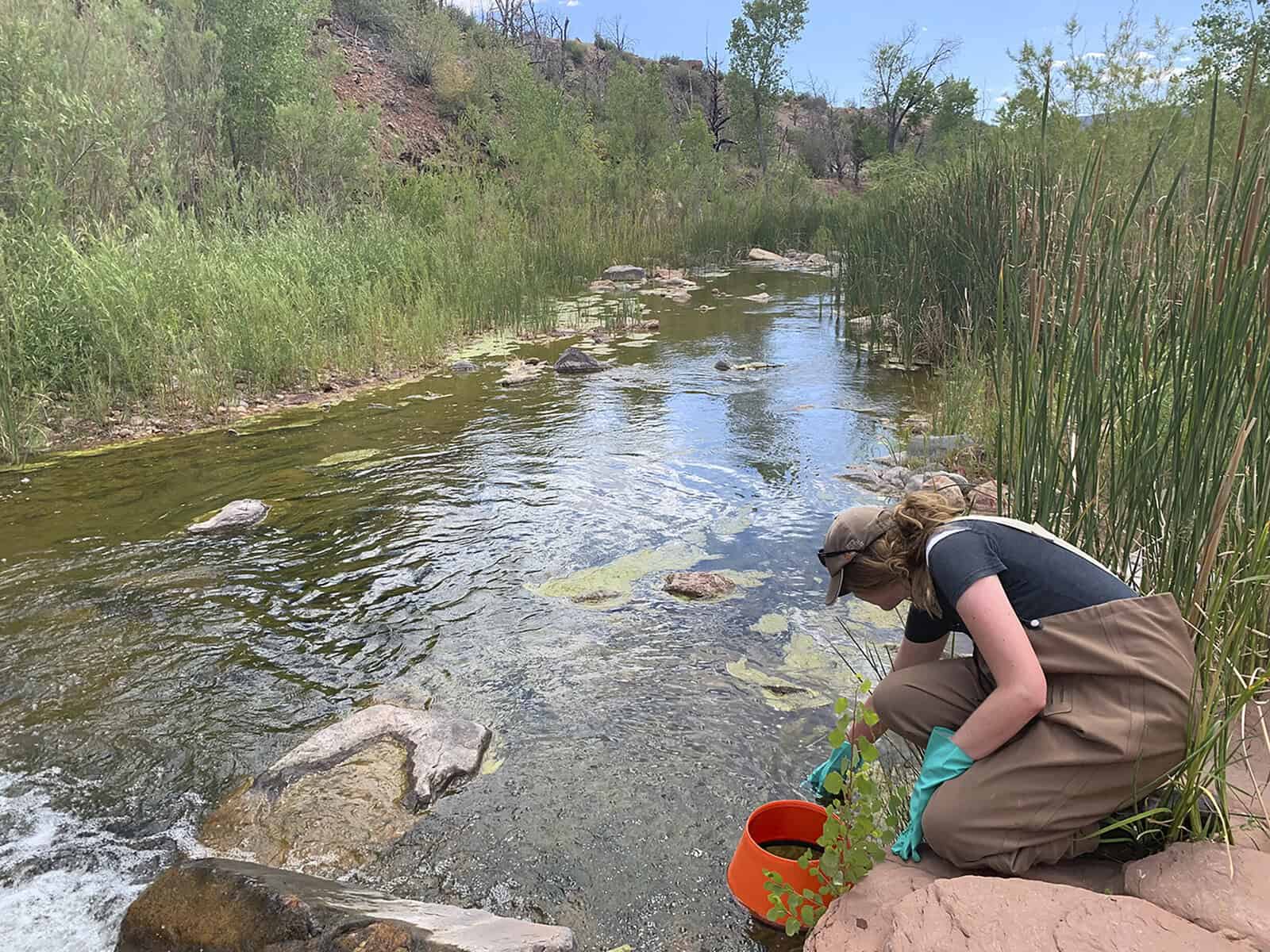

Researcher Hannah Bonner conducts a visual monitoring survey of benthic cyanobacteria in North Creek, a tributary of Utah’s Virgin River. Image credit: Emily Butko (photographer).
In the clear shallows of Utah’s Virgin River, a slimy brown glob clings to the streambed. Hannah Bonner stands shin-deep in the water, eyeing the goo. It looks like Microcoleus, a toxic genus of cyanobacteria that was first detected in the river four years ago. Microcoleus doesn’t pose much risk underwater. Occasionally, though, a clump gets dislodged and floats to the surface, where a dog or child might eat it. Ingesting even a tablespoon can deliver enough neurotoxin to kill a toddler.
Bonner, an ecologist with the state’s division of water quality, hikes the rocky banks of the Virgin River regularly, surveying the riverbed for toxic cyanobacterial mats. When she finds a big one, Bonner asks any downstream waders to get out of the river, then walks over and stomps on the goo. Her heavy boots dislodge the cyanobacteria and break open its cells, releasing toxins and tissue into the water. Bonner dips a 5-gallon bucket into the churning soup and collects a sample, which she sends out to be tested for concentrations of several toxins, the deadliest of which is anatoxin-a. The method mimics the worst-case exposure scenario, Bonner explains—a kid splashing and playing on the riverbank disturbs an area of mat and accidentally takes a drink.
Laminated paper signs are mounted at popular river access points, warning swimmers not to dunk their heads, drink the water, or let their dogs splash. When toxin concentrations are high, additional signage warns visitors not to touch the water at all.
That worst-case scenario hasn’t happened yet. But in Utah and other states, managers are worried, as detections of toxic cyanobacteria continue to rise. In California, the Santa Rosa regional water board has reported growing concerns along the Russian, Snake, and Eel rivers since 2015, with incidents, most often dog deaths, as far back as the early 2000s. At least 19 nations worldwide now report at least one detection (1).
What’s odd is that Microcoleus and other toxic river cyanobacteria are not turning up in polluted waterways, notes ecologist Joanna Blaszczak at the University of Nevada, Reno. Indeed, the reasons for the uptick in sightings are still a matter of some debate—and concern.
Utah has been monitoring Microcoleus in the Virgin River monthly since 2020, when a puppy died over July 4th weekend after snapping at floating cyanobacteria along a riverside trail in Zion National Park. The incident caught the state by surprise. “It wasn’t something we were even worried about or thinking about,” Bonner says. Zion attracts more than 5 million visitors a year—many of whom come to hike The Narrows, a pinch point in Zion Canyon where visitors wade in the water—so there was immediate concern that other families might be at risk.
The Park Service and Utah Department of Environmental Quality quickly mobilized. They collected toxin samples and surveyed for dangerous cyanobacteria in popular areas of the park. Three tributaries, they found, were lined with mats of Microcoleus and several other toxic genera. Today, Zion National Park and an interagency collaborative team including the Utah Division of Water Quality and the recreational water program continue to monitor the Virgin River monthly, surveying the riverbed for potentially toxic cyanobacterial mats. Laminated paper signs are mounted at popular river access points, warning swimmers not to dunk their heads, drink the water, or let their dogs splash. When toxin concentrations are high, additional signage warns visitors not to touch the water at all.
Most well-studied cyanobacterial species drift as plankton in lakes and estuaries, where populations typically explode in response to nitrogen and phosphorus runoff from agriculture, Blaszczak explains (2). But river-bottom species, rather than drifting in dirty water, hide in plain sight, clinging to rocks and cobbles in sparkling clean, nutrient-poor ecosystems. And they don’t release their toxins unless disturbed. Part of what makes benthic river cyanobacteria so dangerous, Blaszczak says, is that they lurk in the most […]
Full article: www.pnas.org
Clean water is essential for life, yet millions of Americans unknowingly consume contaminants through their…
Human brains contain higher concentrations of microplastics than other organs, according to a new study, and the…
From the Office of the Governor: In anticipation of a multi-day, significant atmospheric river in Northern California,…
From Governor Newsom: Scientists, water managers, state leaders, and experts throughout the state are calling…
Photo: A harmful algal bloom in Milford Lake, Kansas, made the water appear bright green.…
An expanded plastic foam coffee cup is at a donut shop in Monterey Park, California.…